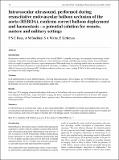Intravascular ultrasound, performed during resuscitative endovascular balloon occlusion of the aorta (REBOA), confirms correct balloon deployment and haemostasis - a potential solution for remote, austere and military settings.
Abstract
Introduction Resuscitative endovascular balloon occlusion of the aorta (REBOA) is rapidly evolving as an emergency haemorrhage control technique. It has wide potential applicability in remote and austere settings, and following military trauma where prolonged field care might be required. However, rapid confirmation of balloon delivery is a challenge which relies on estimates derived from anatomical measurements or trans-abdominal ultrasound. In addition, confirmation of adequate balloon expansion is difficult. Intravascular ultrasound (IVUS) offers a solution to these two issues, making REBOA a deliverable therapy in the pre-hospital and early hospital settings.
Citation
Rees , P , Buckley , AM , Watts , SA & Kirkman , E 2018 , ' Intravascular ultrasound, performed during resuscitative endovascular balloon occlusion of the aorta (REBOA), confirms correct balloon deployment and haemostasis - a potential solution for remote, austere and military settings. ' , Journal of the Royal Naval Medical Service , vol. 104 , no. 1 , pp. 12-17 .
Publication
Journal of the Royal Naval Medical Service
Status
Peer reviewed
ISSN
0035-9033Type
Journal article
Collections
Items in the St Andrews Research Repository are protected by copyright, with all rights reserved, unless otherwise indicated.

